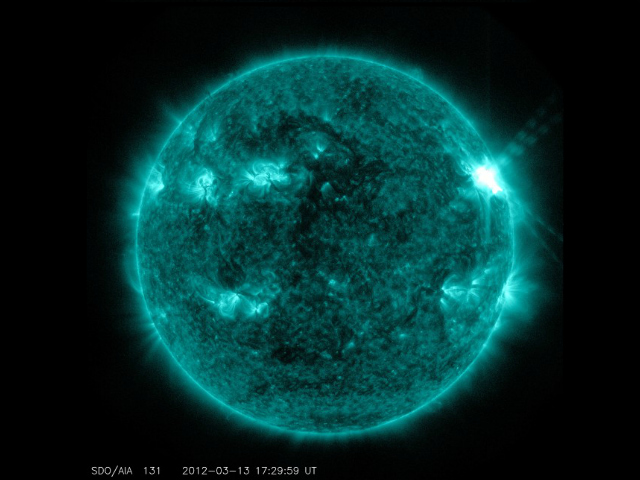Our sleeping sun
Scientists wonder what's in store as sun activity lingers at lowest in over a century
Sarah Lewin • December 2, 2013

Our sun is showing fewer dark sunspots and bright solar flares than expected right now [Image credit: NASA via Wikimedia Commons]
Today’s space weather: The sun is quiet… too quiet.
I should clarify: The surface of the sun is normally peppered with dark spots caused by magnetic activity. Those spots, small by the sun’s standards, can be larger than the surface of the Earth.
I should clarify further: The sun has an incredibly complicated, ever-changing magnetic field, which is caused by the movement of charged plasmas on the surface coupled with the sun’s rotation. Sunspots are areas of intense magnetic activity that appear without warning, although the overall number does follow a predictable cycle.
Ever since they had the tools to do so, scientists have been tracking the strange spots traversing the sun, which linger anywhere from days to months before dissolving and releasing a piece of the sun’s magnetic field. Over the years, scientists have identified an approximately 11-year cycle. After a big buildup in which sunspots and other solar activity become more frequent, the sun’s magnetic poles will suddenly flip. After that, the sunspots die down again.
The last time the sun’s magnetic field reversed was in 2001, so we’re about due for another. But this solar cycle has been incredibly slow, with almost no sunspots at all during the 2008-09 solar minimum (the trough of the 11-year cycle).
Even now, at what’s supposed to be the cycle’s peak, there have only been around half as many sunspots as scientists predicted.
This has led scientists to wonder whether the maximum already happened or whether we’re seeing a lull in between a double maximum. Or maybe the sun’s just tired out from all the end of the world hype.
And the magnetic reversal has been lazy, too: Once a sunspot meets its end, the magnetic charge flows toward a pole, lessening the pole’s magnetism. The pole eventually switches to the opposite charge, and the other quickly switches, too – or at least, that’s what usually happens. In the current cycle, one pole switched over a year ago, and the other is lagging behind much longer than usual. For now, the sun is like a magnet with two south poles. (I ran that analogy by a physics major who recoiled in horror – I should mention that it’s really more like an incredibly complex interplay of positive and negative fields, in which a lot of positive charge is concentrated at one end, but negative charge is still dispersed.)
Once the other side flips, we won’t feel much on Earth. However, the sun’s heightened charge will shield us from deep space’s cosmic rays more than usual, and the aurora might be even more spectacular than usual as we get hit by extra solar radiation.
The sun hasn’t been this slow at a supposed peak since 1906, and scientists are curious to see whether it’ll keep falling or pick back up in the next cycle. If it keeps falling, it might usher in a time of very little solar activity, called a grand minimum, which hasn’t happened since the 17th century. A grand minimum would come with an important bonus, since it could at least partially slow the current climate warming.
But for now, we don’t know. In the meantime, we’ll just take lots of pictures of sunspots in case they all disappear, and wait to see what the sun does next. (And try not to panic.)
2 Comments
It seems like global warming slowed down about 17 years ago.
When the sun flips it’s field (or doesn’t) we might see a burst of sun spots.
But this is the ‘peak’! We will head down into the sun spot minimum and have less and less protection from cosmic rays.
Are those extra cosmic rays going to cause our skies to be more over-cast?
That’s what the CERN CLOUD experiment results show will happen.
I’m sitting here now with 2 layers on and two pairs of socks,
starting to think global warming is one of the weaker forces at work.
And I’m wondering if it’s going to be colder next year? And the year after.
Are we starting into another Maunder Minimum/Little Ice Age?
Hey! Why does cable have to show “The Day After Tomorrow” so much these days? ;)
Seems to me the “scientists” are look for an excuse for not much global warming. I personally need all the global warming I can get, living in Montana as I do and loving to grow tomatoes in my garden. This is (if true) very bad news for me.